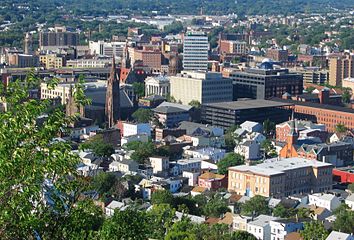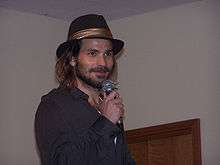Chilean Americans
Chilean Americans (Spanish: chileno-americanos, chileno-estadounidenses, norteamericanos de origen chileno or estadounidenses de origen chileno) are Americans who have full or partial origin from Chile.
| Total population | |
|---|---|
| 172,062 (2018)[1] 0.05% of the U.S. population (2018)[1] | |
| Regions with significant populations | |
| Miami metropolitan area, Greater Los Angeles, New York metropolitan area, Washington Metro Area | |
| Languages | |
| Chilean Dialect (Spanish), American English | |
| Religion | |
| Roman Catholicism | |
| Related ethnic groups | |
| Hispanic Americans, Indigenous Chileans, other European Americans |
| Hispanic and Latino Americans |
|---|
|
National origin groups
|
|
Political movements
|
|
Organizations
|
|
Ethnic groups |
|
Lists
|

The Chilean population from the U.S. census was 126,810. In the United States, Chileans are the fourth smallest Hispanic group from South America and the fifth smallest overall amongst all Hispanic groups. Chilean Americans live mainly in the New York Metropolitan Area, South Florida, Los Angeles County, San Francisco Bay Area (esp. San Mateo County) and the Baltimore-Washington Metropolitan Area, with high population concentrations found in Queens in New York City; Northern New Jersey; Miami, Florida; and Nassau County, New York. Most Chileans migrating to the United States settle in metropolitan areas. After the 1960s, Chileans began to immigrate more for economic or academic rather than political reasons and that continues into the modern day.
History
Chileans and other South Americans have been present in the state of California since the 1850s gold rush. Not all Chileans made it to the gold fields. Some remained in San Francisco, San Jose, Sacramento, and Stockton where they frequently worked as bricklayers, bakers, or seamen. Some with capital established themselves in various businesses, particularly the importation of flour and mining equipment from Chile. In the cities most tended to congregate and live in specific areas in the poorer sections of town. In the gold fields they lived in separate camp sites. In the summer of 1849 Chileans constituted the majority of the population of Sonora. Chileans frequently worked their mines as group efforts. When the placer gold ran out around Sonora the Chileans were amongst the first miners in California to extract gold from quartz.[2] Historical remnants of those settlements influenced the names of locations such as Chileno Valley in Marin County, Chili Gulch in Calaveras and Chili Bar in Placer which was named after Chilean road builders. Names of Chilean towns and places are often found in the names of streets in Northern California: Valparaiso, Santiago, and Calera.[3][4]
After Allende was overthrown and a military regime was established in 1973, a large exodus of Chileans took place. Most fled to European countries, but a small group did emigrate to the US. The US government took these Chileans as refugees under a program for "political parolees."
Many of San Francisco's streets carry names of former residents of Chile: Atherton, Ellis, Lick, Larkin, and others. Chilean women also left their names: Mina and Clementina. Manuel Briseño, an early journalist in the mines was one of the founders of the San Diego Union. Juan Evangelista Reyes was a Sacramento pioneer as were the Luco brothers. Luis Felipe Ramírez was one of the City Fathers in Marysville. The Leiva family owned at one time, much of the land in Marin County, including Fort Ross. In 1975, Chilean exiles of the Augusto Pinochet dictatorship established La Peña Cultural Center in Berkeley, California, which is to this day the largest Chilean cultural center in the United States.
Chilean Americans have achieved many skills as entrepreneurs, judges, congressmen, and others.
Motives of immigration
Most Chilean immigration to the U.S. has occurred largely since the 1990s.[5] For the most part, Chileans left as either political asylees and refugees during the dictatorship of Augusto Pinochet, or for economic reasons. The involvement of the United States in Salvador Allende's overthrow in 1973 led to political exiles fleeing from Chile to the U.S., as well as other countries.[6]
Also, there have been others that have emigrated to seek higher education and career development opportunities. Since the 1960 Valdivia earthquake and with 2010 Chile earthquake, many Chileans have pursued economic opportunities in the United States, with Paterson, New Jersey, representing an increasingly common destination.
Many of the Pinochet-era immigrants were of middle or upper class origin. A significant proportion of them arrived with advanced educations and well-developed skills. They had contacts with other Chilean exiles and a sense of identity from their shared commitment to a democratic Chile. After a period of adjustment, many of them were able to pursue skilled jobs or professions. Unfortunately, others, who lacked skills or whose professional certifications were not recognized in the United States, were forced to take low-level jobs in which they were unable to use their skills. Some had been politically active students or union leaders in Chile who did not enter the United States with easily transferable skills.[5]
The second major arrival into the United States was mainly for economic or academic opportunities. Yet, in general, acquiring a U.S. Visa requires the applicant to have a stable economic background, so most Chileans emigrating to the United States since 1990 have done so mostly for study purposes or to further their academic backgrounds.[5]
Identity
Most Chileans are castizos, meaning their ancestry is one quarter indigenous and three quarters Spanish and/or other Caucasian heritage. They rather identify themselves as both Hispanic and white.[7] Some Chilean-owned stores and restaurants advertise as French and Italian.[7] Many often prefer living in white suburban neighborhoods in the U.S., and have a strong sense of family.[7]
Demographics
Population by state
The 10 US states with the largest population of Chilean Americans are:
- California – 24,006
- Florida – 23,549
- New York – 15,050
- New Jersey – 8,100
- Texas – 6,282
- Virginia – 4,195
- Maryland – 4,146
- Utah – 3,364
- Massachusetts – 3,045
- Illinois – 2,753
Population by urban agglomeration
The largest populations of Chilean Americans are situated in the following urban areas:
- New York-Northern New Jersey-Long Island, NY-NJ-PA MSA – 20,688
- Miami-Fort Lauderdale-Pompano Beach, FL MSA – 17,161
- Los Angeles-Long Beach-Santa Ana, CA MSA – 10,471
- Washington-Arlington-Alexandria, DC-VA-MD-WV MSA – 6,963
- San Francisco-Oakland-Fremont, CA MSA – 4,000
- Boston-Cambridge-Quincy, MA-NH MSA – 2,622
- Houston-Sugar Land-Baytown, TX MSA – 2,570
- Chicago-Joliet-Naperville, IL-IN-WI MSA – 2,454
- Riverside-San Bernardino-Ontario, CA MSA – 2,066
- Orlando-Kissimmee-Sanford, FL MSA – 1,884
- Atlanta-Sandy Springs-Marietta, GA MSA – 1,779
- Seattle-Tacoma-Bellevue, WA MSA – 1,776
- San Diego-Carlsbad-San Marcos, CA MSA – 1,730
- Dallas-Fort Worth-Arlington, TX MSA – 1,686
- Philadelphia-Camden-Wilmington, PA-NJ-DE-MD MSA – 1,505
- Salt Lake City, UT MSA – 1,463
- San Jose-Sunnyvale-Santa Clara, CA MSA – 1,397
- Las Vegas-Paradise, NV MSA – 1,376
- Tampa-St. Petersburg-Clearwater, FL MSA – 1,215
- Phoenix-Mesa-Glendale, AZ MSA – 1,211
Population by city proper
- New York City, New York – 7,026
- Los Angeles, California – 4,112
- Miami, Florida – 1,427
- Houston, Texas – 934
- San Diego, California and Chicago, Illinois – 876
- San Francisco, California – 754
- Miami Beach, Florida – 739
- Washington, DC – 697
- San Jose, California – 632
- Doral, Florida – 622
- Kendall, Florida – 613
- Hialeah, Florida – 602
- The Hammocks, Florida – 564
- Pembroke Pines, Florida – 558
- Fontainebleau, Florida – 549
- Hollywood, Florida – 542
- Kendale Lakes, Florida – 469
- Las Vegas, Nevada – 467
- Boston, Massachusetts – 405
- San Antonio, Texas – 374
- Union City, New Jersey – 372
- Charlotte, North Carolina – 368
- Philadelphia, Pennsylvania – 357
- Coral Springs, Florida – 342
- Miramar, Florida and Austin, Texas – 340
Population by percentage
US communities with the highest percentages of Chileans as a percent of total population: (Source: Census 2010)
- Brookeville, Maryland – 3.73%
- Manorhaven, New York – 3.57%
- Oyster Bay, New York – 2.67%
- Warm Springs, Virginia – 1.63%
- Dover, New Jersey – 1.55%
- Key Biscayne, Florida – 1.50%
- Sleepy Hollow, New York – 1.48%
- Forest Home, New York – 1.40%
- Doral, Florida – 1.36%
- Victory Gardens, New Jersey – 1.32%
- Wharton, New Jersey – 1.27%
- The Crossings, Florida – 1.18%
- The Hammocks, Florida – 1.11%
- Inwood, New York – 1.10%
- North Lynbrook, New York – 1.01%
Chileans are more than 1% of the entire population in only fifteen communities in the US. These communities are mostly located in Miami-Dade County, Morris County, NJ, and Nassau County, NY.
Traditions and Customs
Most Chileans have customs that blend well into the American lifestyle. The Chilean workday is similar to the American workday, with the regular businessman or woman working 45 hours a week[8] from 8:30 am to 6:30 pm with a lunch break, as well as possibly staying behind at work for a few hours to work overtime. However, many Chileans outside Santiago are used to going home for lunch, something not as common in the US and with Chilean Americans.
Unlike the "normal" American diet, Chileans are used to having four meals a day. Breakfast, lunch, tea (or onces) at about five o'clock, and a late dinner. Most people actually have onces at around 8 pm and skip dinner. Surprisingly, Chile is one of the only Latin countries where tea is a more popular drink than coffee, differing from American consumption trends as well
Notable people


_4.jpg)
.jpg)


- Alexa Guarachi – Tennis player
- Los Abandoned – Chilean American rock band
- Marjorie Agosín – Poet, essayist, fiction writer, activist, and professor.
- Fernando Alegria – Stanford professor
- Marsia Alexander-Clarke – American video installation artist
- Isabel Allende – Chilean writer
- Fernando Alvarez – Jockey
- Cayetano Apablasa (1847–1889) – Land owner and politician in Los Angeles, California. He was son of a Chilean.[9][10]
- Tom Araya – Musician
- Claudio Arrau – Pianist
- Felipe Bazar – U.S. Navy hero
- Natascha Bessez – Singer and beauty pageant
- Nico Bodonczy – Football (soccer) player
- Daniel Borzutzky – Poet and translator
- Diaz Brothers – Musician
- Santiago Cabrera – Actor
- Charissa Chamorro – Actress
- Charmaine – Musician
- Beto Cuevas – Singer
- es:Angélica Castro – Former model, actress and TV presenter (see Wikipedia en español)
- Cristian de la Fuente – Soap opera actor
- Tanya Del Solar – Beauty pageant
- Patricia Demick – Boxer
- Ruperto Donoso – Jockey
- Ariel Dorfman – Educator, activist, and author
- Juan Downey – Artist
- Frank J. Duarte – Laser physicist and author
- Matias Duarte – Inventor
- Sebastian Edwards – Academic and economist
- Paloma Elsesser – Plus size fashion model
- Julio M. Fernandez – Biologist
- Pablo Francisco – Comedian
- Alberto Fuguet – Writer and film director
- Thelma Furness, Viscountess Furness – mistress of King Edward VIII
- Jorge Garcia – Actor
- John Gavin – Actor
- Alexa Guarachi – Tennis player
- Lisa Guerrero – Sportscaster and actress
- Tommy Guerrero – Skateboarder, company owner, and musician
- Claudio Guzmán – Television director, producer, art director, and production designer.
- Fareed Haque – Fusion guitarist
- Alfredo Jaar – Artist, architect, and filmmaker
- Nicolas Jaar – Composer and recording artist
- Alain Johannes – Musician
- Paulina Kernberg – Child psychiatrist and professor
- Mario Kreutzberger – AKA Don Francisco, of US Latino TV host
- Jason Liebrecht – Voice actor
- Vicente Luque – MMA fighter
- Antonio Macia – Screenwriter and actor
- Paloma Mami – Singer
- Benny Mardones – Singer
- Roberto Matta – Surreal painter
- Gordon Matta-Clark – Artist
- Claudio Miranda – Novelist and filmmaker
- Gabriela Mistral – Nobel laureate
- Daniella Monet – Actress
- Harry Hays Morgan Jr. – Diplomat, society figure, and actor
- Ricardo A. Olea – Engineer and scientist
- America Olivo – Actress, singer, and model
- Cote de Pablo – Actress, singer and musical theater actress
- Frank Pando – Actor
- Marko Zaror – Actor
- Pedro Pascal – Actor
- Nicole Polizzi – Reality television personality
- Promis – Singer-songwriter and composer
- Jose Quiroga – Cardiologist
- Horatio Sanz – Comedian, Saturday Night Live
- Elizabeth Schall – Singer, songwriter and guitarist
- Sebastian Soto – Soccer player
- Elizabeth Subercaseaux – Writer
- Steve Thurston – Journalist, entrepreneur, and co-founder, CEO and president of Integrity Ministries
- Mercedes Valdivieso – Chilean writer and Rice University professor
- Arturo Valenzuela – Professor
- Francisca Valenzuela – Chilean poet, singer, songwriter, and pianist
- Leonor Varela – Actress
- Andres Velasco – Economist and professor
- Eugene Warburg – Sculptor
- Alexander Witt – Director
| Lists of Americans |
|---|
| By U.S. state |
| By ethnicity or nationality |
|
|
|
|
|
|
|
|
|
Chileans abroad
Of the 857,781 Chilean expatriates around the globe, 13.3% (114,084) live in the United States, 50.1% reside in Argentina, 4.9% in Sweden, and around 2% in Australia, with the remaining 20% being scattered in smaller numbers across the globe, particularly the countries of the European Union.[11][12][13]
See also
- Demographics of Chile
- Chileans in the United Kingdom
- Chilean Australian
- List of Chileans
Notes
- "B03001 HISPANIC OR LATINO ORIGIN BY SPECIFIC ORIGIN - United States - 2018 American Community Survey 1-Year Estimates". U.S. Census Bureau. July 1, 2018. Retrieved November 25, 2019.
- "Chileans in California". Inn-california.com. Retrieved 17 October 2017.
- "Archived copy". Archived from the original on 2013-11-05. Retrieved 2013-11-06.CS1 maint: archived copy as title (link)
- "American River Rafting – Information, Descriptions, Resources and Conservation W.E.T. River Trips". Raftweb.com. Archived from the original on 2007-08-23. Retrieved 17 October 2017.
- "Chilean Americans - History, Significant immigration waves, Settlement patterns, Acculturation and Assimilation". Everyculture.com. Retrieved 17 October 2017.
- Heredia, Juanita (2012). "South American Latino/a Writers in the United States". The Routledge Companion to Latino/A Literature: 436–444.
- Gomez, Luís (2018). "Chilean Americans: A Micro Cultural Latinx Group". Latinx Immigrants, International and Cultural Psychology. International and Cultural Psychology: 33–52. doi:10.1007/978-3-319-95738-8_3. ISBN 978-3-319-95737-1 – via Springer Nature Switzerland AG.
- Harris Gomez Group, Chilean labour law – Overtime and how it works!
- "Biographies of Famous Citizens," LAGenealogy.com Archived 2010-07-06 at the Wayback Machine
- "R.J. Apablasa Takes Bride," Los Angeles Times, July 13, 1954, page B-1
- "Archived copy" (PDF). Archived from the original (PDF) on 2006-02-13. Retrieved 2008-05-19.CS1 maint: archived copy as title (link)
- "Chile.com.Radiografía a los Chilenos en el Mundo". 22 June 2008. Archived from the original on 22 June 2008. Retrieved 17 October 2017.
- "Archived copy". Archived from the original on 2009-04-16. Retrieved 2008-05-19.CS1 maint: archived copy as title (link)
References
- US Census Chilean Factpage
- Are We Really So Fearful? by Ariel Dorfman Washington Post 10/24/06
Further reading
- Burson, Phyllis J. "Chilean Americans." Gale Encyclopedia of Multicultural America, edited by Thomas Riggs, (3rd ed., vol. 1, Gale, 2014), pp. 479-490. online
- Pike, F. B. Chile and the United States: 1880–1962 (University of Notre Dame Press, 1963).
External links
- Historical Text Archive History of Chileans and the California Gold Rush
- Rosales and the Chilean miners in California PBS American Experience the Gold Rush
- (in Spanish)
- Cámara Chileno Norteamericana de Comercio (AMCHAM) Chilean American Chamber of Commerce
- (in English)
- The Avalon Project (Yale Law School) Chilean Diplomacy
- La Peña Cultural Center a major Chilean community and political activism center in Berkeley, California
